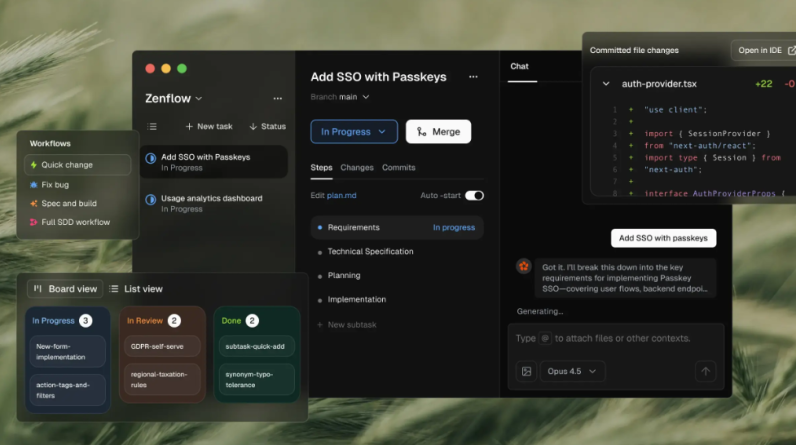Hello and welcome to Eye on AI. In this edition…Honeywell’s AI strategy, OpenAI rethinks its nonprofit structure as Apple and Nvidia consider investing, a new way to build neural networks, and dating apps develop AI “wingmen.”
Last week, I sat down with Honeywell CEO Vimal Kapur in London to discuss his company’s approach to AI. Coincidentally, my colleague John Kell recently interviewed another senior Honeywell exec—CIO Sheila Jordan—about the company’s approach to generative AI for Fortune’s CIO Intelligence newsletter. (You can read John’s story here.)
But while Jordan was keen to tell John about how Honeywell’s own workforce has been experimenting with AI to find productivity gains, Kapur told me he did not think these internal uses of generative AI would confer any great competitive advantage to the firm. That’s despite the fact Honeywell is using generative AI in many ways, from helping teams brainstorm and develop new products to helping with product testing, software coding, technical support, and sales. He said these efforts were vital and necessary—but would soon be imitated by competitors, meaning they were unlikely to provide a lasting edge.
Internal use of AI tools becoming table stakes
“I won’t say it is a substantial disruptor, but it’s a nice opportunity for us to drive productivity,” he said about these internal uses of AI. Honeywell has put a variety of AI tools and copilots to work internally from vendors such as Microsoft and Salesforce, he said. But the use of this kind of AI is increasingly just table stakes. It may let Honeywell grow without having to hire as many people, he said, but it would not alter the strategic landscape in the segments in which Honeywell competes: aviation, industrial automation, building automation, and energy transition.
Instead, the real strategic benefits of AI will come from integrating AI into Honeywell’s offerings to its customers, Kapur said. In many of the industrial and aviation sectors that Honeywell serves, the issue is not that AI is poised to take jobs. Instead, these industries are facing severe labor shortages. There are not enough skilled blue-collar workers—mechanics, electricians, plumbers, construction workers, logistics experts, and machine operators—to fill vacant roles. Kapur says this is particularly true for what is called “touch labor”—in which a human is needed to operate equipment or to maintain it. There’s a shortage of skilled workers almost everywhere worldwide.
Industrial copilots
Kapur thinks Honeywell has the right data to train a stable of AI copilots specifically for these roles that its customers could then use to upskill workers to fill in-demand jobs. “If historically somebody said, ‘This job requires 12 years or 15 years experience,’ well, maybe you’re going to be able to have someone do it with seven years experience, and a supplementer of that is done by copilots, which are part of our products,” he said.
He’s certain that companies in the industries Honeywell serves will rapidly adopt these copilots because there is currently no real alternative. “What’s a Plan B? There is no Plan B,” he said. “There’s no humans to replace the humans who have left the workforce.”
New AI product features
The next area where Kapur thinks Honeywell may be able to jump ahead of competitors is integrating AI directly into products. He gives examples of supermarket checkout scanners, of which Honeywell is a major producer. Today, these scanners work well for bar-coded products. But if you get to the counter with an individual piece of fruit or vegetables where the bar-coded sticker hasn’t been applied or has fallen off, then the cashier must manually look up the price, or the customer is forced to go and weigh the product individually on a separate digital scale, often holding up the line. Kapur says that integrating cameras and computer vision directly into Honeywell’s checkout scanners would enable the scanner to recognize the item and charge the customer appropriately, without delaying the process.
Kapur says Honeywell is working with chip manufacturers, such as Qualcomm, to ensure its scanners are equipped with chips that can efficiently run AI models directly on the device. And he said Honeywell has many ideas for products that might integrate AI in this way, although most won’t hit the market until late 2025 or 2026 due to the 12 to 18 month development and certification process required.
AI for writing engineering specs
The third area where Kapur sees Honeywell using AI to gain an edge is in providing engineering solutions to customers. In many cases, Honeywell doesn’t just sell an off-the-shelf product. It sells a system incorporating several of its products. These are usually built to a customer’s specifications, a task that requires a significant amount of time from the 5,000 engineers Honeywell employs for this work. “We write the solution or spec for the project every time and we do tens of thousands of projects in our business every year,” he says.
Kapur says Honeywell wants to build a large language model that can streamline this spec writing process, so that what currently takes as long as a month could be completed in just minutes—with engineers checking the output for perhaps a few additional days to guard against the risk of AI “hallucinations.” The time savings would be hugely attractive to a construction firm trying to complete a major project such as building a hotel or a hospital on time.
This idea of searching for AI applications that can transform a company’s offering to its customers, and not just as a way to create internal efficiencies and save costs, is one that is likely to characterize the next wave of AI adoption.
Here’s more AI news.
Jeremy Kahn
jeremy.kahn@fortune.com
@jeremyakahn
Correction, Sept. 3: Due to an editing error, an earlier version of this story misspelled Honeywell CEO Vimal Kapur’s last name in several instances. The story has also been updated to clarify Kapur’s position on the company’s internal use of generative AI.
Before we get to the news. If you want to learn more about AI and its likely impacts on our companies, our jobs, our society, and even our own personal lives, please consider picking up a copy of my book, Mastering AI: A Survival Guide to Our Superpowered Future. It’s out now in the U.S. from Simon & Schuster and you can order a copy today here. In the U.K. and Commonwealth countries, you can buy the British edition from Bedford Square Publishers here.
This story was originally featured on Fortune.com







